White Bordeaux, in The Flesh: The Distinctive Dry Whites of Pessac-Léognan and Sauternes Demand Close Attention in Fourteen Châteaux (White 7-Bottle Sampler Pack $348)
Location, locution, libation: The three cardinal rules of real estate are thus rewritten when the Bordeaux turns white, as some back-story is required for a true appreciation of the breed. Check out a list of the priciest wines on record and the bulk of them are red Burgundies and Bordeaux, and the only one that is white is a 1907 Heidsieck that sunk to the bottom of the ocean in a torpedoed submarine and is probably undrinkable.
In general (with a handful of notable exceptions, led by Sauternes) Bordelaise white wine stirs fewer passion lees than the fabled Cab/Merlots. Not that there is much white wine made; only 8% of Bordeaux is planted to white wine grapes and the bulk of that winds up bottled under the generic ‘Bordeaux Blanc’ label. Varieties consist of Sauvignon Blanc (54%) and Sémillon (31%), with Muscadelle, Sauvignon Gris and Ugni Blanc making up the remaining spicy and aromatic fraction.
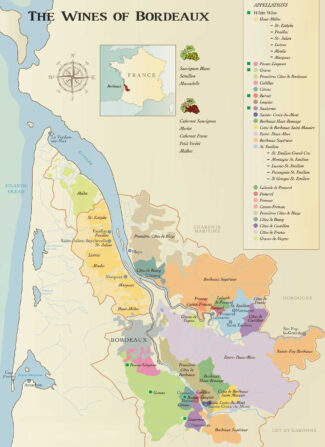
This week, we will peel back the multilayered curtain that occasionally reduces white Bordeaux to an afterthought; a few examples of both first and second wines that will highlight how Sauvignon and Sémillon-driven wines from Bordeaux stand apart from those in the rest of the world.
Two thousand years of tradition and innovation pays dividends, and that sort of savoir-faire is color blind.
Defining White Bordeaux: Diverse Soils, Variety of Styles
Of course, the most unfair thing you can do to a roster of individual and unique wines is to group them together in a single category. White Bordeaux is no exception. At the very least, two distinct styles emerge from the gravel and clay: Crisp, aromatic and fruit-forward wines, and deeply textured wines, often fermented or matured in oak. To label these two styles ‘casual’ and ‘serious’ does a disservice to the circumspection and planning that is required to create them, so it is probably more valuable to simply suggest that the lighter style is ideal for the spring and summer, and the richer, more brooding wines are better for fall and winter.
In terms of terroir, what’s soil for the goose is also soil for the gander. Bordeaux is situated mostly inland but thrives on its proximity to water—the Atlantic Ocean hosts a tributary called the Gironde which then splits into two more rivers—the Dordogne and the Garonne. With this coastal influence, the gravelly soils take on minerals deposited by the water. In general, the crisper, seafood-friendly style of white Bordeaux comes from Entre-Deux-Mers, meaning ‘Between Two Seas.’ Here, the gravel drains easily and lends a steely minerality to the wines that is quite attractive. The meatier wines tend to come from Pessac-Léognan and Graves, and are often made with more Sémillon; they hold more weight and texture and continue to improve with age.
Sampler Package ($348): Seven Dry Whites from Seven Great Estates in Pessac-Léognan & Sauternes
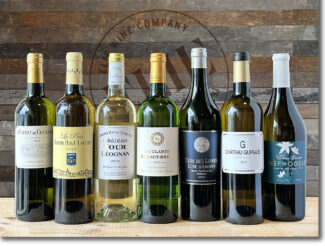
This introductory package contains the wines numbered 1-7 below; a marvelous introduction to the second wines of many famous estates and the primary whites of others.
White Pessac-Léognan: Sauvignon Blanc Like No Other
In 1987, a long-standing wrong was righted: The villages of Pessac and Léognan were singled out from the greater Graves region and given their own appellation. This move acknowledged that the wines of the newly-formed Pessac-Léognan were unique from surrounding villages in both depth and focus. Among the estates able to claim the new appellation title was the Premier Cru Château Haut-Brion.
Most of the area remains staunchly red—among the 4000 acres of Pessac-Léognan vineyard, more than 75% are planted to Cabernet Sauvignon and Merlot. It is the remainder that we will focus our attention upon: Unlike the famous sweet white wines from nearby Sauternes, Pessac-Léognan whites are generally crisp, dry and mineral-filled, with citrus notes, often with rich character notes added through oak aging and capable of improving for up to a decade. They are made predominantly from Sauvignon Blanc and Sémillon, a duo that thrives in the sandier soils of the appellation and results in some of the most stunning examples of this blend that can be found.
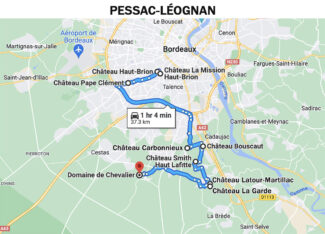
Domaine de Chevalier
Grapes may be the stock and trade of Pessac-Léognan, but as a land mass, it is mostly forest. Carved into a clearing in that forest, Domaine de Chevalier has been a mainstay of wine production in the region for hundreds of years. So much do the trees influence the wines that one of the first things Olivier Bernard did when he took over the estate (at the age of 23) in 1983 was to remove the sheltering belt that surrounded those acres most susceptible to frost.
At the time, the estate had only 44 acres of vines. Among Bernard’s other early decisions was to retain the winemaking team and enlarge the holding. In 1985, he purchased additional plots from neighboring vineyards; next, he began a long-term replanting program lasting from 1988 to 1995, including in this 17 acres of Sauvignon Blanc and Sémillon.
Today, he is joined in daily operations by his two sons Adrien and Hugo. With 65 acres under vine, divisible into 90 individual plots, the potent Pessac-Léognan terroir is built around gravel with black sand over clay and hardpan soil. There are gentle slopes and elevations throughout the parcel which rise to around 200 feet, relatively high for Bordeaux.
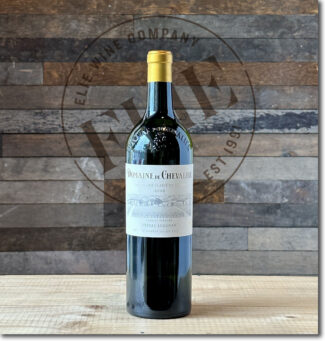 Domaine de Chevalier, 2019 Pessac-Léognan Blanc ($153)
Domaine de Chevalier, 2019 Pessac-Léognan Blanc ($153)
70% Sauvignon Blanc and 30% Sémillon, the wine performs beautifully with hints of green apple, cream, lavender, pineapple and light honey followed by a crisp slate finish.
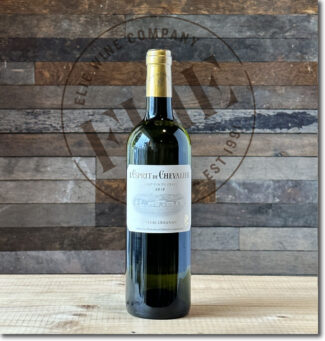 •1• Domaine de Chevalier, 2019 ‘L’Esprit de Chevalier’ Pessac-Léognan Blanc ($37)
•1• Domaine de Chevalier, 2019 ‘L’Esprit de Chevalier’ Pessac-Léognan Blanc ($37)
The estate’s second wine, the 2019 L’Esprit de Chevalier Blanc offers a beautiful sense of salty minerality as well as citrus blossom, white flowers and a hint of lime; as intended, it is a mini-Chevalier Blanc, medium-bodied with bright acidity and a mineral finish.
Château Smith Haut Lafitte
Rated as a red wine ‘Grand Cru Classé’ in the 1959 Classification of Graves, the château sits on a low hill of pebbles and sand deposited by the Garonne River, offering grape vines not only superb drainage, but also reflected sunshine to lengthen the day’s ripening period. The estate, of course, is not to be confused with Château Lafite Rothschild (the Pauillac superstar) with which it has no connection, but both were named for their elevated physical status—‘la fite’ is an ancient dialectical word for hill.
The château is owned and managed by Daniel Cathiard and Florence Cathiard, who purchased the estate in 1990 from the well-known Bordeaux négociant and importer Louis Eschenauer. The attraction, according to Daniel, was that Smith Haut Lafitte was one of the few Bordeaux vineyards producing both red and white wines.
In the production of Sauvignon Blanc-dominated white blends, Smith Haut Lafitte is known for whole berry fermentation using a pneumatic press; there is no skin contact or malolactic allowed and vinification takes place in French oak barrels, where the wine is aged on their fine lees for a year.
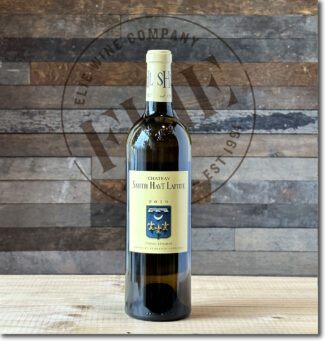 Château Smith Haut Lafitte, 2019 Pessac-Léognan Blanc ($189)
Château Smith Haut Lafitte, 2019 Pessac-Léognan Blanc ($189)
Mostly Sauvignon Blanc blended with a splash of Sauvignon Gris and Sémillon. The wine offers textbook notes of honeyed lemon, melon, caramelized grapefruit and orange blossom above a crisp saline finish.
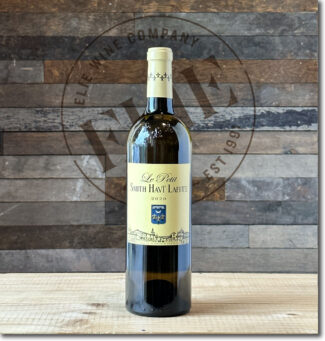 •2• Château Smith Haut Lafitte ‘Le Petit Haut Lafitte’, 2020 Pessac-Léognan Blanc ($53)
•2• Château Smith Haut Lafitte ‘Le Petit Haut Lafitte’, 2020 Pessac-Léognan Blanc ($53)
80% Sauvignon Blanc and 20% Sémillon aged in 50% new barriques; it offers luscious scents of fresh Bosc pears, lemongrass and green guava plus hints of white pepper and wet stone.
Château Carbonnieux
An estate with which even a casual wine drinker is probably familiar. With more than 420 acres under vine, it is easily the largest vineyard in Pessac-Léognan, and one of the largest in Bordeaux. Its wines are widely available in the United States—especially the whites, since the acreage is evenly divided between red and white; 65% Sauvignon Blanc and 35% Sémillon.
In 2011, the property embarked on an extensive renovation that would allow it to vinify on a parcel-by-parcel basis. Added were temperature-controlled, stainless steel vats in a myriad of sizes (ranging from 150 hectoliters to 250 hectoliters). The whites of Château Carbonnieux are vinified in 25% new, French oak barrels where malolactic also takes place, as aging done for an average of 10 months before bottling.
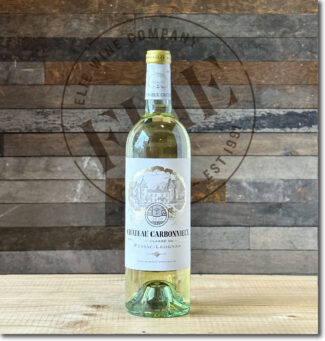 Château Carbonnieux, 2020 Pessac-Léognan Blanc ($50)
Château Carbonnieux, 2020 Pessac-Léognan Blanc ($50)
The clay and limestone of Garonne gravel found in the Pessac-Léognan Appellation produces the best dry white wines in Bordeaux region. When young, Carbonnieux Blanc is delightfully refreshing and pure with a fruity, floral intensity and when allowed to mature, develops hints of dried and candied fruits.
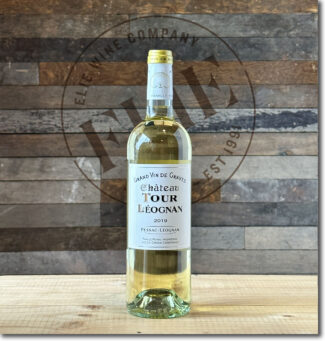 •3• Château Tour Léognan, 2019 Pessac-Léognan Blanc ($28)
•3• Château Tour Léognan, 2019 Pessac-Léognan Blanc ($28)
Originally a distinct estate located adjacent to Carbonnieux, both properties were purchased by Marc Perrin in 1956, and when he reorganized the vineyards, he designated Tour Léognan as the second wine of Carbonnieux. Today, Tour Léognan is made from the younger vineyards of Château Carbonnieux—vines younger than 12 years of age—but it follows the same process and production care as its bigger brother. It shows clean honeydew and moist granite notes, and with exposure to aeration in a glass, develops gunflint, grapefruit pith and notes of dried vanilla bean.
Châteaux Haut-Brion – La Mission Haut Brion
Lest there be any confusion, Haut-Brion (the only First Growth that doesn’t come from Haut-Médoc) sits opposite La Mission Haut Brion in Pessac, a suburb of Talence. At one time, they were owned by different folks. From 1919 and 1983, the Woltner family ran La Mission, and under them, the estate experienced one of its most significant string of excellent vintages. It was then considered entirely on the level with First Growths and sometimes even better, and in 1983, the owners of Haut Brion purchased La Mission Haut Brion. Today, Jean Philippe Delmas is responsible for this property. When you look at the differences in the soils and higher level of vine density at La Mission Haut Brion than at Haut Brion, it is easier to understand the differences in the wine’s styles.
Of Chateau La Mission Haut Brion’s 75 vine acres, 66 are given over to red wine grapes and the rest for white. 61.7% Sémillon and 38.3% Sauvignon Blanc, on average, 37 years of age. For the production of Château La Mission Haut Brion Blanc, the grapes are harvested in the pre-dawn hours—according to Jean Philippe Delmas, the cool night air preserves the freshness in the fruit and retards oxidation, allowing more purity to shine through in the fruit. After the early morning sorting, the grapes are crushed via pneumatic press with no contact between the juice and the skins. The wines are barrel fermented in 100% new Allier oak. There is no malolactic fermentation and almost no stirring of the lees.
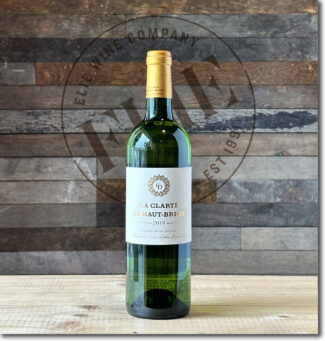 •4• Châteaux Haut-Brion – La Mission Haut Brion ‘La Clarté de Haut-Brion’, 2019 Pessac-Léognan Blanc ($126)
•4• Châteaux Haut-Brion – La Mission Haut Brion ‘La Clarté de Haut-Brion’, 2019 Pessac-Léognan Blanc ($126)
Formerly known as ‘Les Plantiers du Haut-Brion’, the grapes for ‘La Clarté’ are sourced from both Château Haut-Brion and Château La Mission Haut-Brion. The wine shows exotic spice and tropical flavors, especially passionfruit, and finishes with struck-match smoke.
Château La Garde
Domaine de Lagarde featured on the first general map of the Kingdom of France drawn up in 1756. Since then, it has undergone many name changes— Domaine de la Garde, Clos de La Garde and finally, Château La Garde. The vineyard stretches over a magnificent gravel plateau and outcrops, while the impressive winery was built next to the charterhouse in 1881.
The vineyard features vines that average 25-year-old; density is high, with some plantings as dense as 14,000 vines per hectare. The terroir is gravel with clay soils for most of the vineyard, but a smaller 10-acre parcel features cooler temperatures and a bigger proportion of limestone, and this is reserved for the white wine grapes, 85% Sauvignon Blanc and 15% Sémillon.
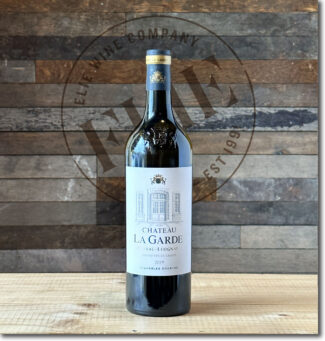 Château La Garde, 2019 Pessac-Léognan Blanc ($49)
Château La Garde, 2019 Pessac-Léognan Blanc ($49)
76% Sauvignon Blanc, 14% Sémillon, 10% Sauvignon Gris: A brisk-edged mineral expression shows on bouquet with a hint of lemon pith and ‘fleur de sel’ notes followed by a core of white peach and gooseberry. The delicately toasty finish reflects perfectly integrated barrel-aging.
Château Latour-Martillac
The iconic tower standing at the gateway of Château Latour-Martillac (for which the property is named) is all that remains of a fortified medieval castle, began in the early 1940s when the estate was expanded in size, especially with land devoted to red wine grapes. Prior to this, close to 75% of the estate was devoted solely to the production of white wine—it was one of only six properties in Graves classified for both red and white wines. In 1955 Jean Kressman became the owner of Latour-Martillac, although he had managed it since 1940. Today, two of his sons, Tristan and Loic, manage the château.
Of the 130 acres under vine, 25 are set aside for Sauvignon Blanc and Sémillon, 60% and 40% respectively. Some of the Sémillon, it is noted, is the oldest in the appellation, having been planted in Gratte vineyard in 1884. To vinify, these grapes are whole-cluster pressed and fermented in 22% new French oak, then aged on its lees in barrel for an average of 15 months before bottling.
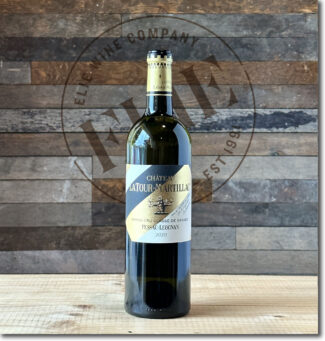 Château Latour-Martillac, 2020 Pessac-Léognan Blanc ($48)
Château Latour-Martillac, 2020 Pessac-Léognan Blanc ($48)
58% Sauvignon Blanc and 42% Sémillon, richly textured from the additional time on the lees. Hints of vanilla and crushed stone are undertones to the core of citrus zest, white flowers, green apple and ripe nectarine.
Château Bouscaut
Owned by the Lucien Lurton family for 43 years, Château Bouscaut is managed today by Sophie Lurton and husband Laurent Cogombles as well as their son, Armand Cogombles.
About 25 of the 130 acres are set aside for white varieties, with an increasing focus on Sauvignon Blanc although there is a small plot of ungrafted Sémillon that was planted in 1850. Otherwise, the property—although large—consists of a single parcel of vines growing on a sloping hillside of gravel, clay and limestone.
After receiving HVE3 certification in 2018, Château Bouscaut began converting to 100% organic farming and are officially certified as organic with the 2023 vintage.
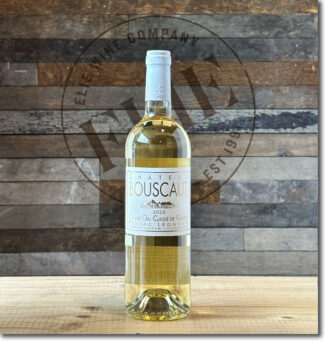 Château Bouscaut, 2020 Pessac-Léognan Blanc ($52)
Château Bouscaut, 2020 Pessac-Léognan Blanc ($52)
Vinification of the two varieties takes place separately; the Sauvignon Blanc is fermented in combination of new and used French oak while the Sémillon sees 35% new oak barrels. There is very little skin contact allowed and no malolactic fermentation; it is blended just before bottling. The wine displays green apple hard candy with honeysuckle notes on sweet, mildly-spiced palate.
Château Pape Clément
One of the oldest Bordeaux Grand Crus, the estate’s vineyard was established by Bertrand de Goth, who in 1305 became Pope Clément V, the name which was subsequently given to the Château. The first harvest there took place in 1252.
In 1980, Bernard Magrez acquired the estate, not his first by any means, and it must be noted that he manages 42 wineries around the world. Still, it is said that the output of Clément has never been better, thanks in part to his attention to the basics of quality: Lower yields, picking riper fruit, increased parcel-by-parcel work in the vineyards, making a severe selection in the vineyards and improving the barrel-aging program. Over the past several years, the vineyards have almost doubled in size.
Today, Château Pape Clément sprawls across 150 acres, of which about 17 are reserved for white varietiess. This includes a very precise breakdown—those vines are planted to 48.5% Sémillon, 44.5% Sauvignon Blanc, 5.5% Sauvignon Gris and 1.5% Muscadelle. Under Magrez, white wine production has tripled. Gravel, clay, sand over limestone soils and a cooler microclimate lend authority and depth to these white grapes where vines are planted at an average vine density of 7,700 vines per hectare and are on average, 34 years old.
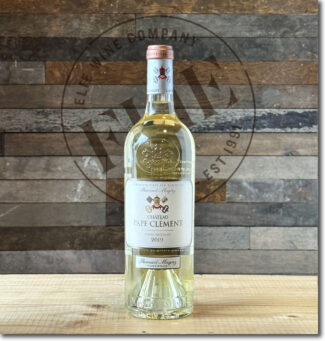 Château Pape Clement, 2019 Pessac-Léognan Blanc ($189)
Château Pape Clement, 2019 Pessac-Léognan Blanc ($189)
The flagship white of Pape Clément is 46% Sauvignon, 40% Sémillon and the balance Sauvignon Gris; fermented in barrel, large-sized oak casks and 15% in concrete, egg-shaped vats. The wine shows a perfect balance between deep savory texture and brightly assertive citrus and stone fruit behind kumquat, fresh thyme, flint, stone and oyster shell.
Sauternes’ Other (Dry) White Bordeaux: Sémillon Showcase
‘Dry Sauternes’ is not an appellation, although perhaps it should be, thus allowing vintners to fetch the kind of prices to which they might otherwise aspire, especially in vintages where making sweet Sauternes is impossible—mainly through the absence of botrytis. In fact, they are marketed under the name ‘Bordeaux Blanc’ and many are a showcase for Sémillon, producing phenomenally rich wines with (somewhat like their sweet cousins) a marzipan and spiced dried fruit character. It is true that some winemakers find vinifying a dry version of Sauternes is difficult since the soils and climate differ from the outstanding white wine regions like Pessac-Léognan.
Château Doisy-Daëne in Barsac (one of Sauternes’ five villages) claims to be the first classified growth to produce a dry wine, beginning in 1948. “Sweet wines were doing very well. It was a shame to produce a dry White Bordeaux in a classified estate,” explains Jean-Jacques Dubourdieu, vigneron at Château Doisy-Daëne says of his great-grandfather’s decision.
Sauternes vintners don’t describe any specific climactic conditions preferable for parcels destined for sweet-versus-dry production, and this makes sense considering the château model, where estates harvest fruit from their contiguous properties rather than sourcing from multiple vineyards. As a result, all of these sites have the propensity to develop noble rot, leaving that question out of the equation when choosing dry parcels. Instead, vignerons might choose their dry wine plots based on varietal composition or vine age (typically setting aside the older vines for Sauternes), but commonly, the dry wine portions of the vineyard are decided upon before the growing season and rarely alter between vintages.
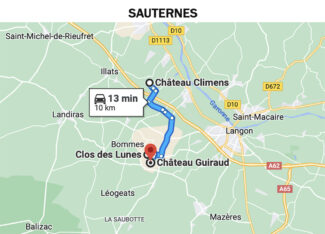
Clos des Lunes
(Domaine de Chevalier)
When Olivier Bernard, (from an old Cognac-producing family) bought the Domaine de Chevalier in 1983, the estate was ranked among the Crus Classés for both red and white wine in the Classification of Graves of 1953 and 1959. In 2011 he embarked upon a shocking project: ‘Clos des Lune’s, in which he wanted to produce the best dry white wine in Bordeaux by taking grapes destined to craft perhaps the most desirable dessert wine in the world (Sauternes) and create instead a dry white wine which would sell for under $25.
The 111 acre estate is planted to 70% Sémillon and 30% Sauvignon Blanc. The vines are old, with an average age of 30 years. Lune d’Argent is the heart of Clos des Lunes’ production, and the estate refers to this wine as the ‘La Grande Cuvée.’
All work done is organic with the goal of moving to a complete, self-sustaining vineyard. Bernard says, “In Sauternes, respect for nature is inextricably linked with the region’s viticultural heritage. The development of botrytis can only occur in a vineyard where the environment is protected. Reconversion to organic agriculture is relatively straightforward. A traditional, natural, manual approach in the vineyard and winery has been passed on from generation to generation.”
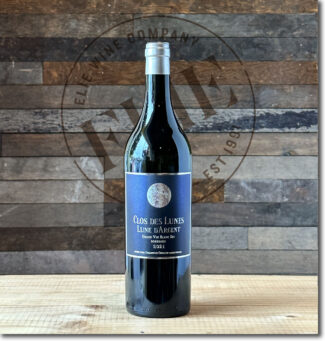 •5• Clos des Lunes ‘Lune d’Argent’, 2021 Bordeaux Blanc ($24)
•5• Clos des Lunes ‘Lune d’Argent’, 2021 Bordeaux Blanc ($24)
Tart and quite tropical with crushed citrus, pineapple, and white flower notes. With a touch of French oak, the Sémillon is dense and rich, the Sauvignon Blanc refined and precise. This cuvée is vinified dry, but promises to convey all the magic of Sauternes.
Château Guiraud
Talk about specificity: Château Guiraud states its location as being ‘between the church bell and the first vines of D’yquem.’ Chances are, those vines are Sémillon, since that great estate is predominantly planted to this variety. Robert Peugeot and three wine makers—Olivier Bernard, Stephan Von Neipperg and Xavier Planty—purchased the estate in 2003.
And what a purchase! Guiraud is massive at 250 acres. The soil is 80% of gravel and 20% of gravel mixed with clay, and sub-soils mostly sand. Varieties are broken down to 65% Sémillon and 35% Sauvignon Blanc. Harvests, in an effort to find grapes with ideal ripeness and noble rot, are done by hand, in six individual passes. About 17 acres are reserved for ‘Le G de Guiraud’—the dry version.
Guiraud was certified organic wine in 2011, but had been practicing it since 1996—the first of the 1855 Premier Crus to do so.
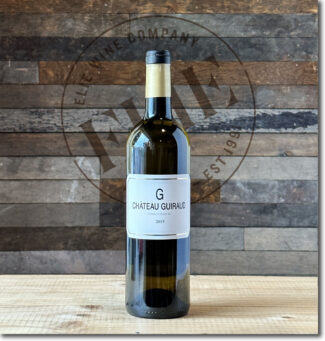 •6• Château Guiraud ‘Le G de Guiraud’, 2019 Bordeaux Blanc ($25)
•6• Château Guiraud ‘Le G de Guiraud’, 2019 Bordeaux Blanc ($25)
An even blend of Sémillon and Sauvignon Blanc, aged seven months in the oak barrels that produced the previous year’s Grand Cru, the wine is expressive and complex showing Meyer lemon, mint leaves, mandarin orange and a lot of minerality in the finish.
Château Climens
Known as the ‘Lord of Barsac’ with a history dating back to the 16th century, the current owner Jean-Hubert Moitry represents only the sixth family to run the estate since its inception. The storied terroir distinguished it as a Premier Cru Classé vineyard, and its surface area in a continuous single vineyard has remained virtually unchanged since the date of its creation.
“Acquiring a wine estate in the Bordeaux region corresponds to a longstanding family dream,” says Jean-Hubert Moitry, co-founder of Patrimonia Développement, a Paris-based wealth management firm. “My wife Catherine,” he adds, “comes from a family of wine merchants from Meymac in Corrèze.”
The single block on the prestigious Barsac plateau is planted entirely to Sémillon. The previous owner Bérénice Lurton managed the estate for the past three decades, overseeing its transition to organic and biodynamic farming. Following the wider trend in Sauternes, she also created a dry white wine, Asphodèle, in 2018 and she remains at the château as an advisor.
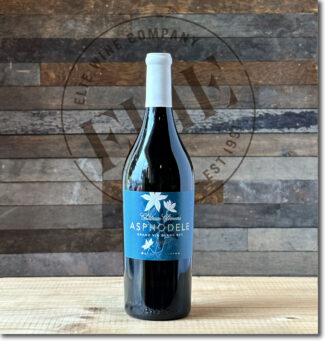 •7• Château Climens ‘Asphodèle’, 2019 Bordeaux Blanc ($55)
•7• Château Climens ‘Asphodèle’, 2019 Bordeaux Blanc ($55)
Made in collaboration with Pascal Jolivet from Sancerre, who employed ‘the Jolivet Method’—grapes harvested at their freshest, spontaneous fermentation by naturally-occurring yeasts, aging on the lees, and an absence of oak, etc. In their obsession to fully develop the potential of the atypical Climens terroir, the Climens team adapted the method to the requirements of biodynamics, and offers a precise reading of a fashioned by the conjunction of red sand and limestone. It is perfumed with lily (from which the name Asphodèle arises) and honeysuckle, offering subtle stone fruits framed by petrichor.
- - -
Posted on 2023.10.03 in Pessac-Léognan, France, Bordeaux, Wine-Aid Packages
Featured Wines
- Notebook: A’Boudt Town
- Saturday Sips Wines
- Saturday Sips Review Club
- The Champagne Society
- Wine-Aid Packages
Wine Regions
Grape Varieties
Aglianico, Albarino, Albarín Blanco, Albarín Tinto, Albillo, Aleatico, Arbanne, Aubun, Barbarossa, barbera, Beaune, Biancu Gentile, bourboulenc, Cabernet Franc, Cabernet Sauvignon, Caino, Caladoc, Calvi, Carcajolu-Neru, Carignan, Chablis, Chardonnay, Chasselas, Clairette, Corvina, Cot, Counoise, Erbamat, Ferrol, Fiano, Frappato, Friulano, Fromenteau, Fumin, Garnacha, Gewurztraminer, Godello, Graciano, Grenache, Grolleau, Groppello, Juan Garcia, Lambrusco, Loureira, Macabeo, Macabou, Malvasia, Malvasia Nera, Marsanne, Marselan, Marzemino, Melon de Bourgogne, Merlot, Mondeuse, Montanaccia, Montepulciano, Morescola, Morescono, Moscatell, Muscadelle, Muscat, Natural, Nero d'Avola, Parellada, Patrimonio, Petit Meslier, Petit Verdot, Pineau d'Aunis, Pinot Auxerrois, Pinot Blanc, Pinot Gris, Pinot Meunier, Pinot Noir, Poulsard, Prieto Picudo, Rondinella, Rousanne, Roussanne, Sangiovese, Sauvignon Blanc, Savignin, Semillon, Souson, Sparkling, Sumoll, Sylvaner, Syrah, Tannat, Tempranillo, Trebbiano, Trebbiano Valtenesi, Treixadura, Trousseau, Ugni Blanc, vaccarèse, Verdicchio, Vermentino, Viognier, Viura, Xarel-loWines & Events by Date
- April 2024
- March 2024
- February 2024
- January 2024
- December 2023
- November 2023
- October 2023
- September 2023
- August 2023
- July 2023
- June 2023
- May 2023
- April 2023
- March 2023
- February 2023
- January 2023
- December 2022
- November 2022
- October 2022
- September 2022
- August 2022
- July 2022
- June 2022
- May 2022
- April 2022
- March 2022
- February 2022
- January 2022
- December 2021
- November 2021
- October 2021
- September 2021
- August 2021
- July 2021
- June 2021
- May 2021
- April 2021
- March 2021
- February 2021
- January 2021
- December 2020
- November 2020
- October 2020
- September 2020
- August 2020
- July 2020
- June 2020
- May 2020
- April 2020
- March 2020
- February 2020
- January 2020
- December 2019
- November 2019
- October 2019
- September 2019
- August 2019
- July 2019
- June 2019
- May 2019
- April 2019
- March 2019
- February 2019
- January 2019
- December 2018
- November 2018
- October 2018
- September 2018
- August 2018
- July 2018
- June 2018
- May 2018
- April 2018
- March 2018
- February 2018
- January 2018
- December 2017
- November 2017
- October 2017
- September 2017
- August 2017
- July 2017
- June 2017
- May 2017
- April 2017
- March 2017
- February 2017
- January 2017
- December 2016
- November 2016
- October 2016
- September 2016
- August 2016
- July 2016
- June 2016
- May 2016
- April 2016
- March 2016
- February 2016
- January 2016
- December 2015
- November 2015
- October 2015
- September 2015
- August 2015
- July 2015
- June 2015
- May 2015
- April 2015
- March 2015
- February 2015
- January 2015
- December 2014
- November 2014
- October 2014
- September 2014
- August 2014
- July 2014
- June 2014
- April 2014
- March 2014
- February 2014
- January 2014
- December 2013
- November 2013
- October 2013
- September 2013
- August 2013
- July 2013
- June 2013
- May 2013
- April 2013
- March 2013
- February 2013
- January 2013
- December 2012
- November 2012
- October 2012
- February 2004
Search



